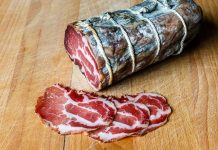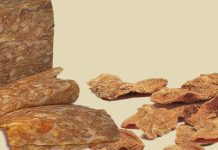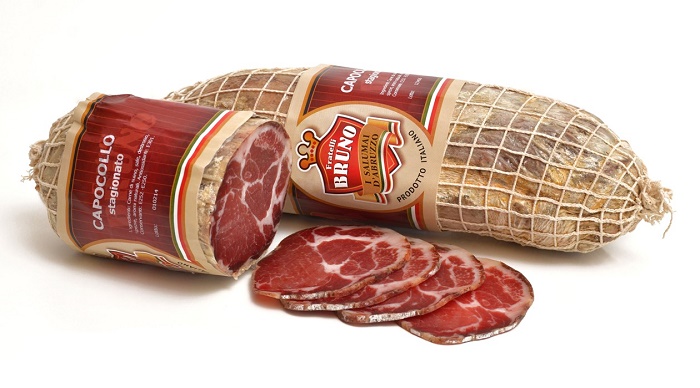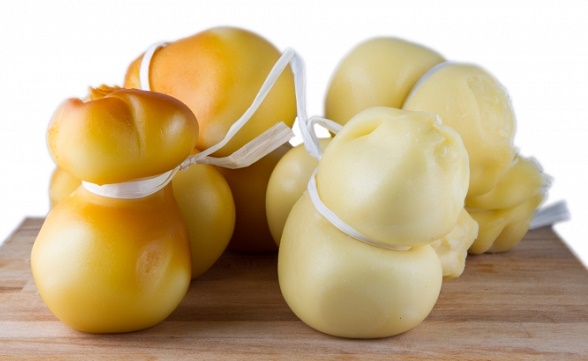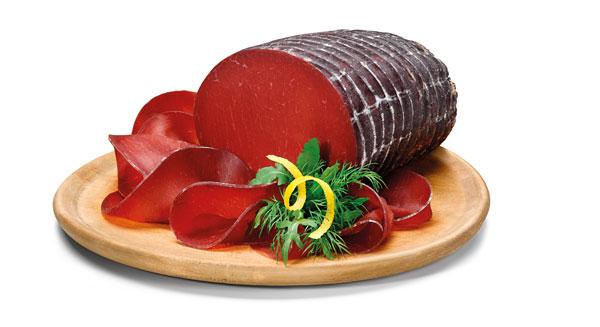
History
One of a many of salted meat products in Italy is the bresaola, which is part of the whole piece raw cured meat, not smoked. In Italy, especially in various regions of the north, the bresaola is done in different ways, which are distinguished by the meat used for the realization of the cold cut, in fact can be beef, horse, deer or even gut realized for stuffing.
The form of the bresaola appears most often in a cylindrical shape or parallelepiped, more or less regular, wrapped by the gray color of the dried gut and can be with or without binding. Once that is cut, its color is intense red, more or less dark according to the choice of meat for the preparation, very compact, with very little fat veins. Bresaola is eaten raw as a cold cut, or served in the table as an appetizer.
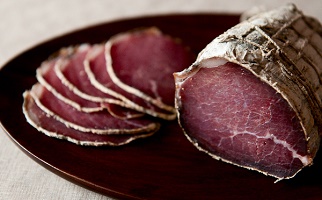
The Bresaola best known in Italy and in the world, is that of the Valtellina, which is made with beef, in the part of punta d’anca (top sirloin coulotte), the tip of the haunch, but are also used anatomical cuts like sub-rump and the topside (round), it is protected by the appellation of typical provenance (ITP).
His name seems to come from the expression “sala come brisa”, a dialectical expression, for the use that was made originally for storage of meat and for the fact that in Valchiavenna (close to the Valtellina valley), the term “brisa” was to indicate a gland of cattle that contained a lot of salt.
Some even brings this term to the word “brasa”, which in local dialect means brace, as in the past, the bresaola was dried in rooms heated by braziers that were fed with fir charcoal and juniper berries, leaves bay leaf and thyme.
Production of bresaola and disciplinary
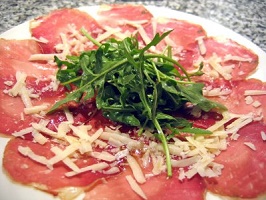
The protected designation of origin, identifies the product for which, at least one of the stages of production, manipulation and processing to obtain the finished product, takes place in a geographic area determined and characterized by a recognized know-how.
The Bresaola of Valtellina is produced and processed in the traditional production area which includes the territory of the city of Sondrio province. The meats that are then used for the realization of this cold cuts, can also come from cattle reared and slaughtered in other areas and can also be imported (Brazil, Argentina). The city of Sondrio, bases its own economy thanks to these imports. To produce the bresaola, it also uses the Irish beef and this is obtained through the muscles of cattle.
The rump, corresponds to the muscle of the thigh and includes the internal rectus muscle, the adductor and the semi-membranous muscle. The most valuable cut is the punta d’anca, which corresponds to the part of topside that is adductor and its minimum weight was deprived of the muscle must be of 2.5 kg up to a maximum of 3.
We also sub-rump, which corresponds to a portion of the posterolateral of the thigh muscles, more precisely the long muscle vast and has a minimum weight of 2 kg.
The topside is the posterolateral portion of the thigh muscles, in particular the semitendinosus muscle and has a minimum of 1 kg weight. Finally, we talk about the sottosso, which corresponds to the front end of the leg, composed of muscle and from that vast exterior, interior and intermediate (quadriceps femoris).
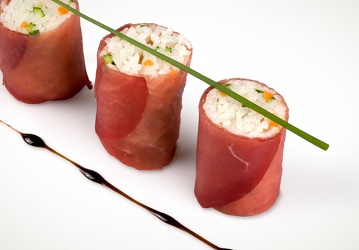
Preparation of Bresaola
The first phase for bresaola making is salting, which is carried out dry, in the large steel tanks where the meat is sprinkled with salt, pepper and herbs. In addition to these products, it can be added some wine, spices, sugars (to promote the microbial phenomena responsible for seasoning), nitrates, nitrites, sodium, potassium, ascorbic acid and sodium salt. The mixture of the salting process can vary according to the manufacturers, and this is handed down as a recipe that is guarded jealously.
The cured beef is salted for about 10 or 20 days, and this also depends on the season, by size, altitude and also the place of processing. Every four days the pieces of dried beef are transferred into other containers, after having eliminated the excess of brine, through a massage, which in turn enables rapid absorption within the salt. With this stage, the meat loses liquid and acquires flavor to be then washed and stuffed into natural or artificial gut (for culinary uses material).
When finished, you go to the next phase, the drying of bresaola that is made in the appropriate cells. The drying allows the product to dehydrate in the first days of the treatment and is carried out at a temperature comprised between 20 and 30 degrees with a humidity rate that varies between 35-65%. The premises for the seasoning, must be strictly fitted with systems for the detection of the humidity and temperature have to have optimum exchange of air.
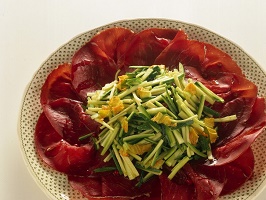
Bresaola for recipes
In Italy the Bresaola is often eat with bread, in panini, but also it is very famous the starter with Parmisan and rocket, or just with lemon or just mozzarella and oil. It is prepared also with zucchini, or for the rolls and sushi. Sometime it is used for pasta condiments or in some rare risotto, instead of the bacon or the ham, or in salads with eggs and other vegetables, like mushrooms.

